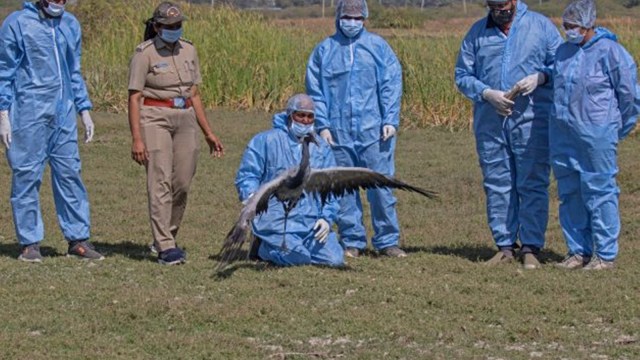Shift towards cotton could affect winter habitat of common, demoiselle cranes: Study
Gujarat sees arrivals of common cranes (CCs) and demoiselle cranes (DCs) by the thousands in September and October.
 Demoiselle crane-1 is released after being tagged by Sasan Wildlife Division. (Photo Credit: Sasan Wildlife Division)
Demoiselle crane-1 is released after being tagged by Sasan Wildlife Division. (Photo Credit: Sasan Wildlife Division)The Change in crop patterns in Gujarat could impact the habitat of migratory cranes in the state known for its birding sites, a study has shown.
With farmers shifting towards cash crops, like cotton, from cereals and water bodies shrinking, the number may get affected of demoiselle and common cranes, the twin species of international migratory birds that come to Gujarat for wintering from their breeding grounds in Russia and Central Asia, the study by the Gujarat Forest Department has concluded. The study also suggests that the nutritious food available in Gujarat could be helping these birds fly thousands of kilometres within days during their return migration.
Gujarat sees arrivals of common cranes (CCs) and demoiselle cranes (DCs) by the thousands in September and October. A large number of demoiselle cranes spend the winter mostly in Saurashtra while common cranes prefer Kutch, the northern part of Saurashtra, and parts of north and central Gujarat regions, birdwatchers say.
However, the study led by Mohan Ram, Deputy Conservator of Forests (DCF) of Sasan Wildlife Division of the state’s Forest Department, in collaboration with Devesh Gadhvi of Jim Corbett Foundation, has suggested that a shift from cereals to cotton and decreasing acreage of groundnut in Gujarat could be altering the habitat of these international migratory birds in Gujarat. The findings have been published in a research paper titled ‘Satellite Telemetry Insights into the Winter Habitat Use and Movement Ecology of Common and Demoiselle Cranes’.
The research paper was published in Birds, an open-access, peer-reviewed journal published by the Multidisciplinary Digital Publishing Institute (MDPI), Basel, Switzerland, on Tuesday.
 Common crane-1, tagged by wildlife division, forages while wintering in Gujarat. (Photo Credit: Sasan Wildlife Division)
Common crane-1, tagged by wildlife division, forages while wintering in Gujarat. (Photo Credit: Sasan Wildlife Division)
As part of their research project funded by the Sasan Wildlife Division, the team tagged two common cranes and two demoiselle cranes at Kaj wetland near Kodinar in Gir Somnath district in January and February last year with solar-powered satellite tags and then studied their movement for a year.
DC-1 started migrating northward from Gujarat on March 25 and reached Russia on April 10, covering a total distance of 12,982 km within 17 days, flying through Pakistan, Afghanistan, Iran, Turkmenistan, Uzbekistan, and Kazakhstan. For its winter migration from Russia, it covered 14,873 km in 71 days. DC-2 took a more direct northward path for flying to its wintering ground in Kazakhstan, flying through eastern Pakistan, Afghanistan, Turkmenistan, and Uzbekistan and covering 4,968 km in 18 days. For its return migration, it covered 7,394 km in 105 days while flying along its spring migration route.
The research paper enunciates that the winter home ranges of both the species in their wintering grounds in Gujarat are much larger than their breeding grounds in central Asia and Russia. In Gujarat, the team observed that CCs showed partiality towards wetlands, grasslands, and croplands while spending the winter in Gujarat, DCs seemed to prefer wetlands and croplands.
“Croplands and water bodies were the most important habitat variables influencing crane presence positively. The changing crop patterns from cereal grains to cotton, coupled with the shrinkage of water bodies within the study area, may raise concerns about their presence during winter in the near future,” the researchers write in their paper.
There are 15 crane species and of them, four occur in India. They are CC, DC, black-necked crane, and sarus crane. The sarus crane is a resident breeder in India, including in Gujarat, while the remaining three are winter migrants. CCs and DCs are winter visitors in Gujarat. The cranes feed on a variety of plant materials including roots, rhizomes, tubers, stems, leaves, fruits, and seeds, the paper notes. But it also underlines that in recent years, farmers of Gujarat are sowing more cotton in place of cereals and this can be a concern for the winter visitors.
Citing various sources, the researchers report that in Gujarat, 12.8 million hectares or 54 per cent of the total geographical area of the state is under agriculture and cotton, groundnut, castor, wheat, pearl millet (bajra), maize, etc are major crops.
“Water bodies and croplands were the most important habitat variables influencing crane presence positively…. In recent years, traditional low-intensity agricultural practices have changed to modern mechanized practices to meet ever-increasing demands arising from human population growth, leading to a change in cropping patterns [62]… However, it has been found that agriculture has shifted from food grains to cotton production [63]. Overall, the share of food grains has declined from 43 per cent in 1994–1995 to 36 per cent in 2014–2015, while the share of cotton doubled from 11 per cent to 20 per cent within the same period [63]. Furthermore, the share of oil seeds such as castor and groundnut declined from 27.1 per cent to 23.9 per cent during the same period [63],” reports the research paper.
The research further underlines that cranes in Eurasia and Africa have coexisted with agriculture and have adapted to traditional low-intensity agriculture, consuming waste grains and crops and feeding in rice paddies.
Talking to The Indian Express, Ram said that Gujarat has become an extremely important habitat for these birds. “These birds spend the better part of the year in their wintering grounds or along their migration route in the Central Asian Flyway. This duration is longer than the time they spend in their breeding grounds in Central Asia. From that perspective, conservation of their habitat becomes very important for long-term conservation of these species as well as to keep vailing ecosystem services that these birds provide to agriculture,” said Ram.
Dhaval Vargiya, president of Mokarsagar Wetland Conservation Committee (MWCC), Porbandar, who has led exercises to estimate populations of CCs and DCs in Porbandar, said that numbers of these two species vary greatly from one year to another. “The estimates of the global population of these two species need an update as sometimes, we have noted two lakh demoiselle cranes in Porbandar, which is almost the entire global population of this species. Secondly, their numbers in Porbandar vary a great deal. But it seems the entire Gujarat is wintering ground from the two crane species and their numbers in Porbandar could be varying as these birds could be wintering elsewhere, demonstrating somewhat weak site-fidelity,” said Vargiya.







